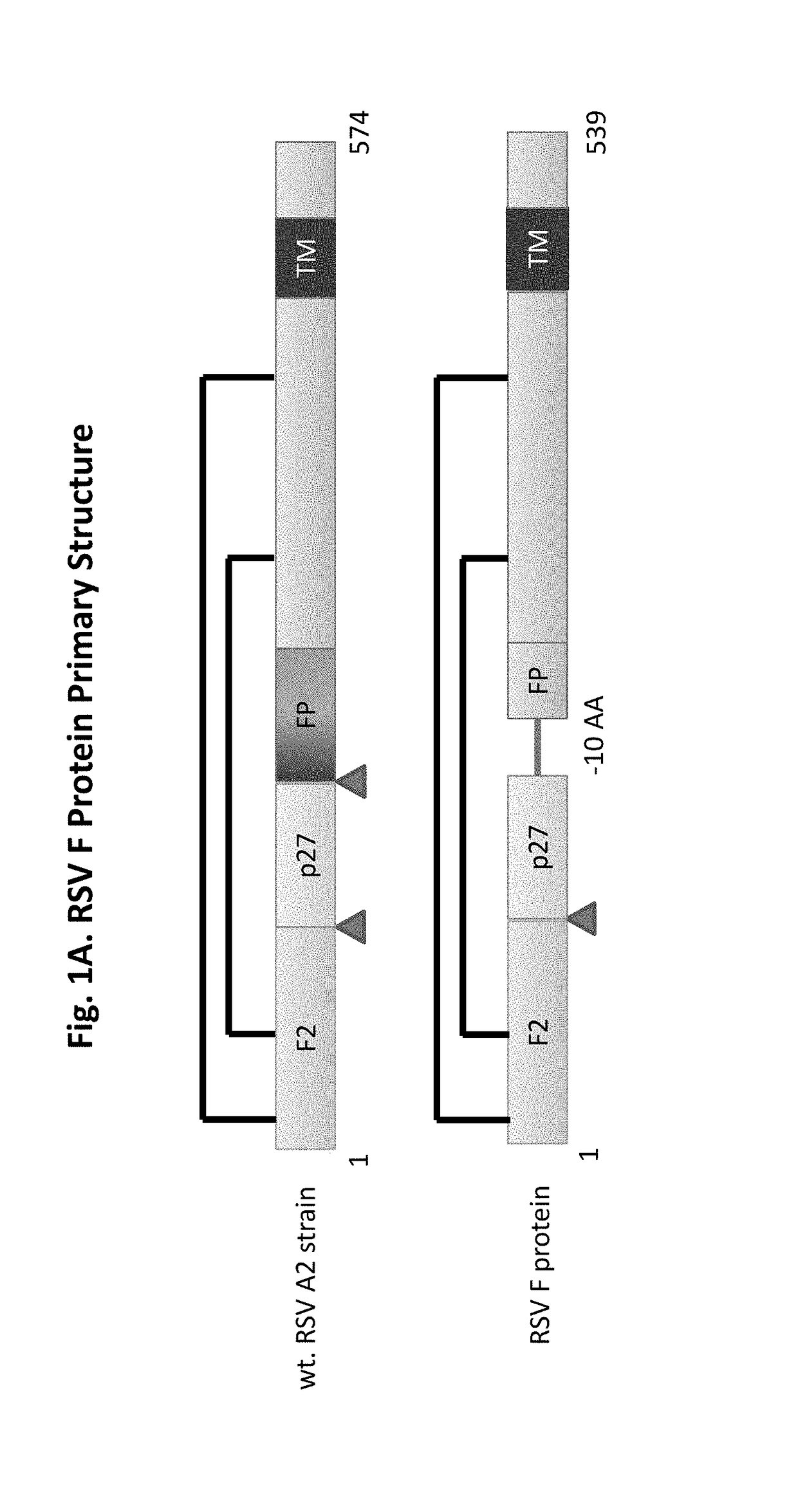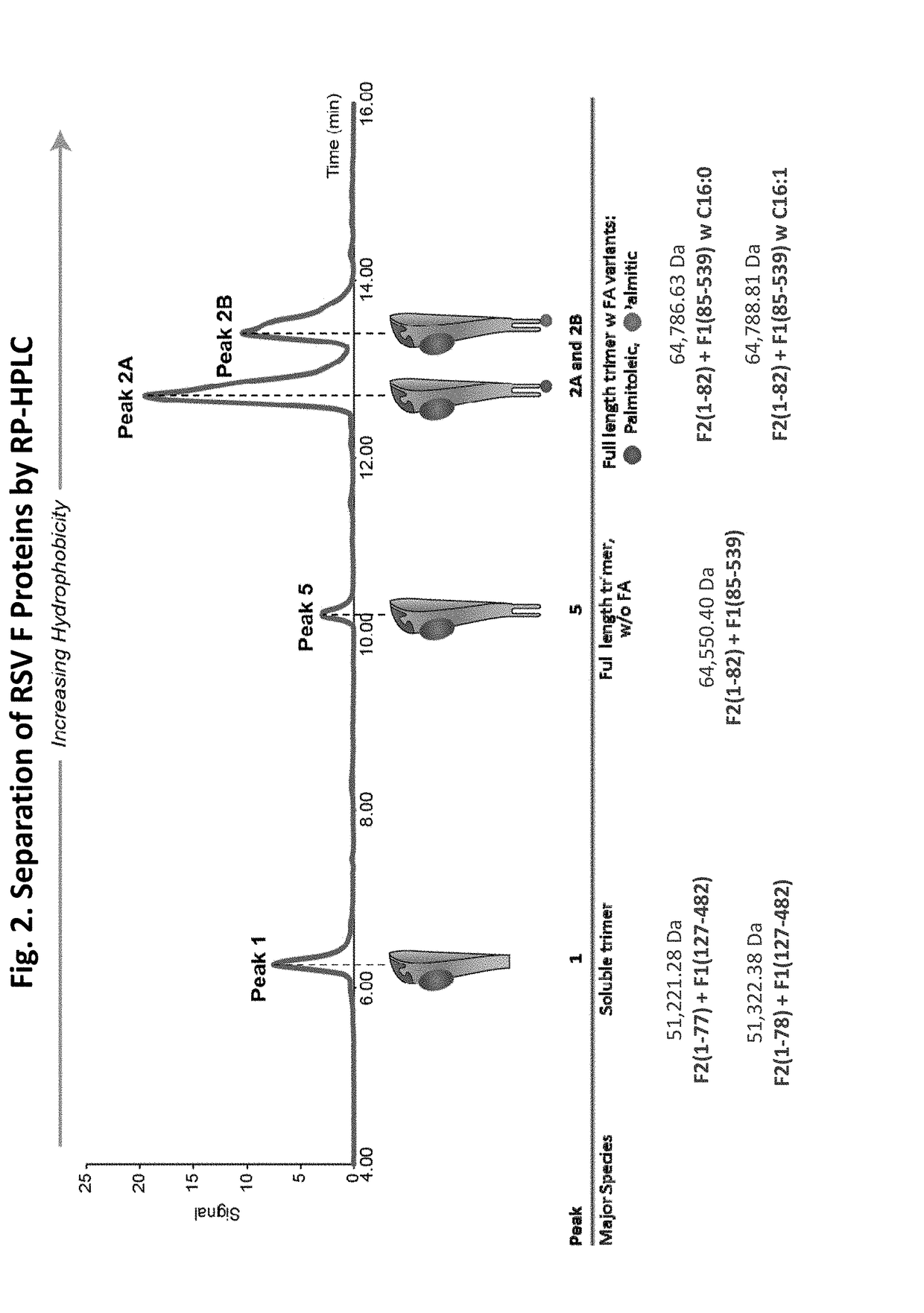Vaccine compositions having improved stability and immunogenicity
a technology of immunogenicity and composition, applied in the field of nanoparticles, can solve the problems of increasing pathology, increasing the risk of infectious diseases, and many remaining threats to human health, and achieve the effects of enhancing thermostability, and reducing the risk of infectious diseases
- Summary
- Abstract
- Description
- Claims
- Application Information
AI Technical Summary
Benefits of technology
Problems solved by technology
Method used
Image
Examples
example 1
[0203]Expression and Purification of an RSV F protein
[0204]An RSV F protein having SEQ ID NO: 8 was expressed in a baculovirus expression system and recombinant plaques expressing the RSV F protein were picked and confirmed. The recombinant virus was then amplified by infection of Sf9 insect cells. A culture of insect cells was infected at ˜3 MOI (Multiplicity of infection virus ffu or phi / cell) with baculovirus. The culture and supernatant were harvested 48-72 hrs post-infection. The crude cell harvest, approximately 30 mL, was clarified by centrifugation for 15 minutes at approximately 800× g. The resulting crude cell harvests containing the RSV F protein were purified as described below.
[0205]Non-ionic surfactant Tergitol® NP-9 (Nonylphenol Ethoxylate) was used in the membrane protein extraction protocol. NP-9 was Crude extraction was further purified by passing through anion exchange chromatography, lentil lectin affinity / HIC and cation exchange chromatography. The washed cells ...
example 2
Preparation of a Vaccine Composition
[0209]To provide nanoparticles for an administered vaccine product, the Drug Substance was diluted into a Drug Product, with a PS80:RSV protein molar ratio of about 50. Drug Substance was thawed, diluted and filled into glass vials or pre-filled syringes for storage at 2-8° C. prior to administration. The nanoparticles bound to alum adjuvant. The alum adjuvant was added and mixed to ensure about 95% of the nanoparticles are bound to the alum is bound, meaning about 0.4 mg per 120 μg dose of RSV F nanoparticle in a 0.5 mL volume.
example 3
Characterization of RSV F Glycoproteins in Nanoparticles
[0210]We analyzed protein structure in the nanoparticles by various analytical techniques. FIG. 3 shows that the highest peak of RSV F protein produced contains palmitoleic acid (Peak 2A). The second largest peak contains palmitic acid (Peak 2B). Residual peaks were obtained lacking either fatty acid (Peak 5) and in soluble form (Peak 1). Analysis on SDS-PAGE gel separated additional variants, including the F1+2 protein, F 1, F1A, F1B, and F1C portions as well as F2. See FIG. 4. Analysis of the peptide structure was performed using peptide mapping. See FIG. 5. To assess the glycan structures on the RSV F glycoproteins, HPLC-FLD was performed. The results demonstrated that the major glycan structures are fucosylated.
PUM
| Property | Measurement | Unit |
|---|---|---|
| molar ratio | aaaaa | aaaaa |
| Z-ave diameter | aaaaa | aaaaa |
| concentration | aaaaa | aaaaa |
Abstract
Description
Claims
Application Information
 Login to View More
Login to View More - R&D
- Intellectual Property
- Life Sciences
- Materials
- Tech Scout
- Unparalleled Data Quality
- Higher Quality Content
- 60% Fewer Hallucinations
Browse by: Latest US Patents, China's latest patents, Technical Efficacy Thesaurus, Application Domain, Technology Topic, Popular Technical Reports.
© 2025 PatSnap. All rights reserved.Legal|Privacy policy|Modern Slavery Act Transparency Statement|Sitemap|About US| Contact US: help@patsnap.com



